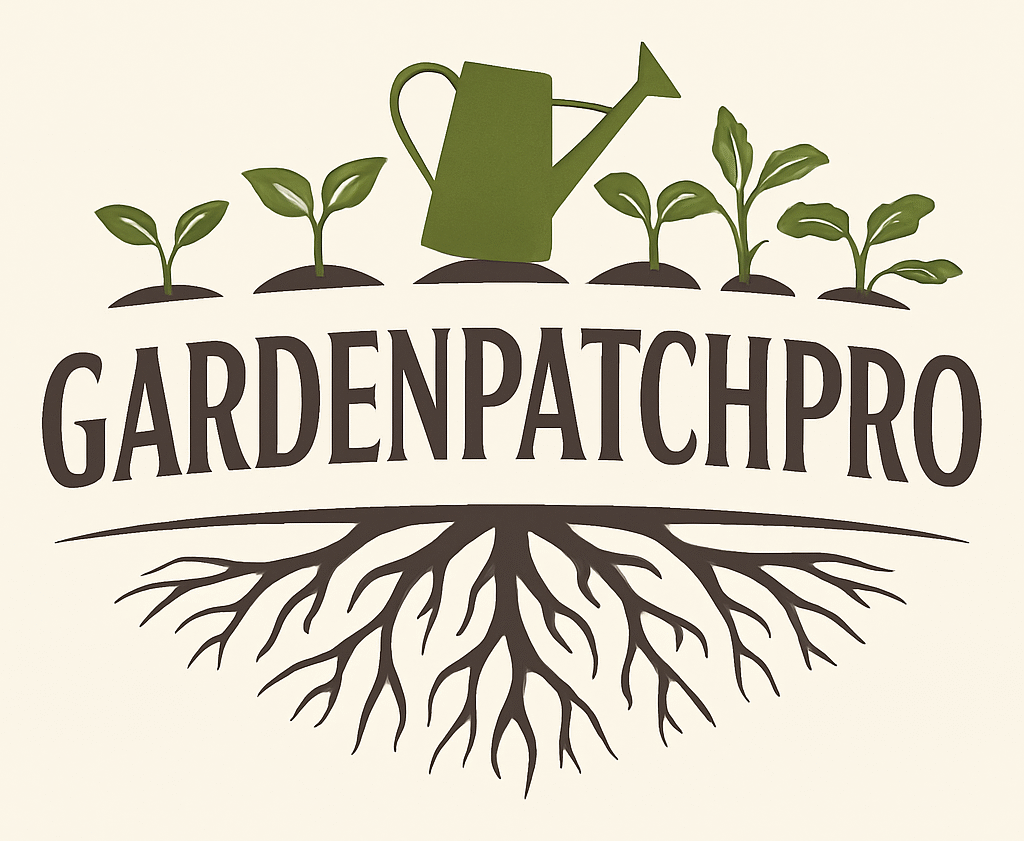8 Vertical Vegetable Garden Ideas for Maximizing Small Spaces Efficiently
Vertical vegetable gardening offers a practical way to grow fresh produce in small or limited spaces. It is especially useful for people living in urban areas or those who want to maximize their garden’s efficiency without needing more ground space.
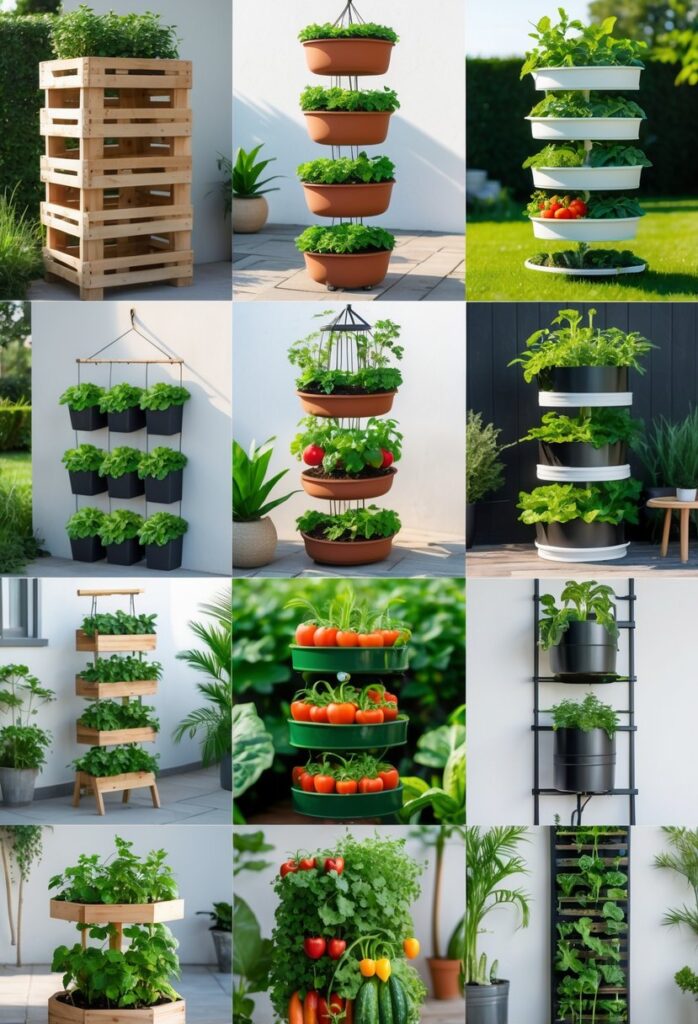
This gardening method allows plants to grow upward, saving space while making care and harvesting easier. Vertical gardens can transform balconies, patios, or even indoor areas into productive green spaces with the right setup and plant choices.
1) Use hanging pocket organizers for compact vertical planting
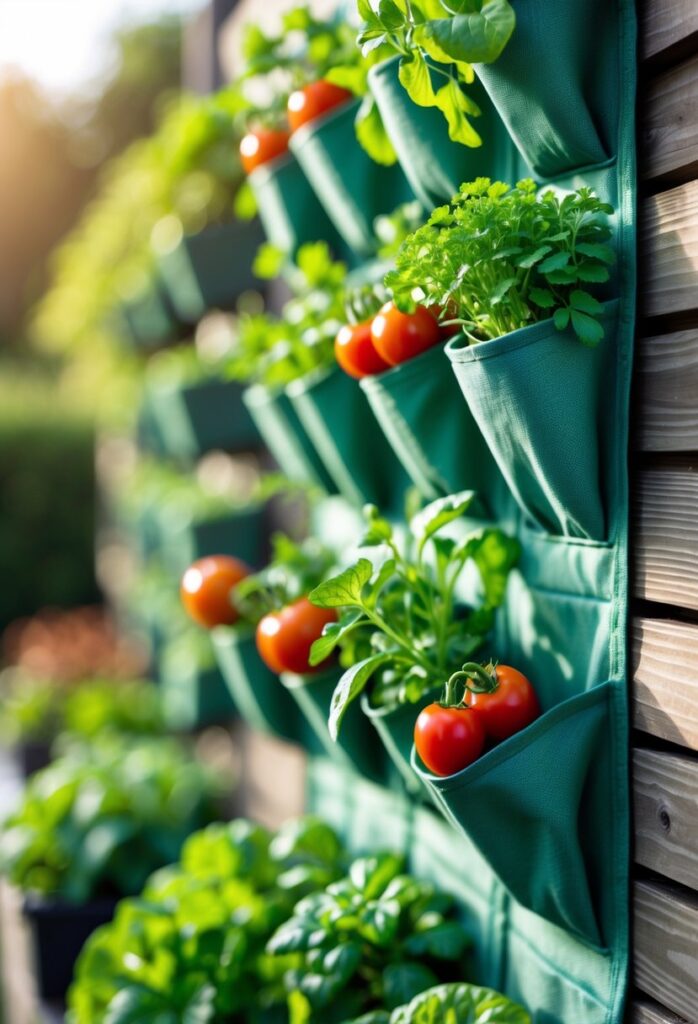
Hanging pocket organizers are a smart way to grow vegetables in tight spaces. Each pocket acts as a small planter, allowing different plants to grow in one vertical setup. This method saves ground space and makes it easier to care for plants.
They work well for shallow-rooted vegetables like herbs, lettuce, or leafy greens. The pockets hold soil and plants securely while allowing good air circulation. This helps keep plants healthy and reduces the risk of overwatering.
These organizers can be hung on walls, fences, or balconies. They are easy to install and move if needed. Using a hanging pocket organizer turns unused vertical areas into productive garden spots.
This idea is simple and affordable, perfect for people with small yards or limited garden space. It also helps keep cats or pests away from the plants. For more ideas on vertical planting with pocket organizers, see this guide on vertical vegetable garden ideas.
2) Build a potato tower to maximize root vegetable space
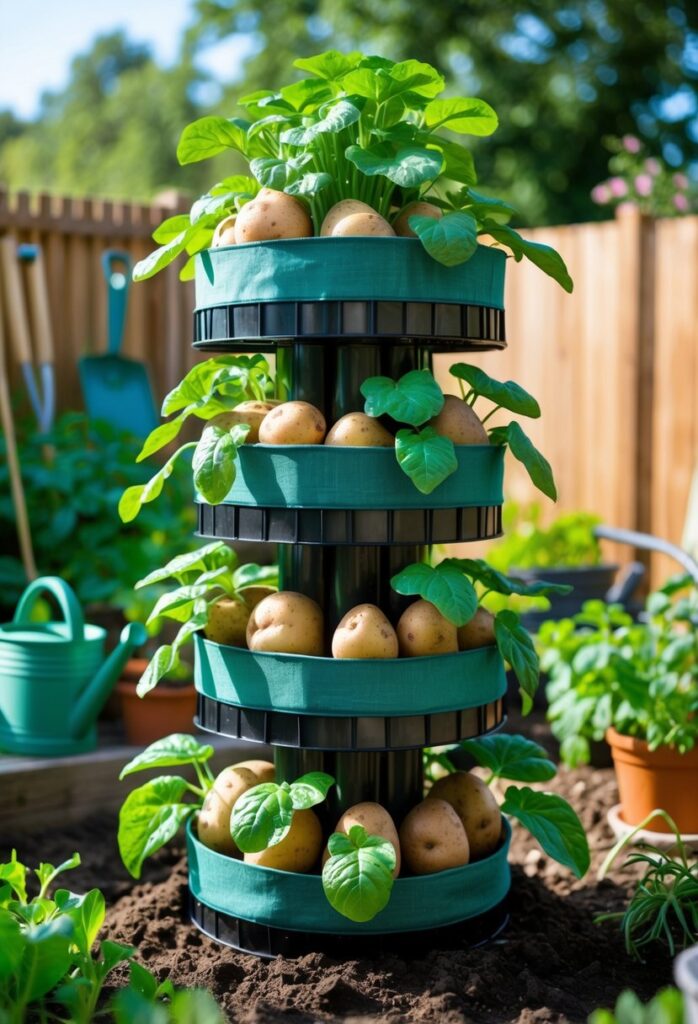
A potato tower is a simple vertical structure that helps save ground space while growing more potatoes. It stands about three to five feet tall and uses layers of soil, straw, and seed potatoes. This setup allows potatoes to grow upward instead of spreading out.
The tower is often made by shaping wire mesh or fencing into a cylinder. It needs a sunny spot with at least six to eight hours of sunlight daily. Good drainage is important, so it should not be placed in low areas where water collects.
As the potato plants grow, soil and organic material are added layer by layer inside the tower. This encourages roots and tubers to form in the new soil, increasing yield from a small space. Harvesting can be easier, too, since many potatoes grow near the surface.
Building a potato tower suits gardeners with limited space or balconies. It is a practical way to get a big harvest from a small area using a vertical garden design. More details on building one can be found in this step-by-step potato tower guide.
3) Install wall-mounted planter boxes for easy access

Wall-mounted planter boxes are a practical way to grow vegetables in small spaces. They attach directly to walls, making it simple to reach and care for plants without bending or kneeling. This setup works well on balconies, patios, or even indoors near a sunny window.
These planter boxes come in various sizes and materials. Using durable options like galvanized metal or treated wood helps them last longer outdoors. It is important to use the right wall anchors to support the weight of the soil and plants safely.
The boxes can hold a variety of vegetables, including leafy greens, peppers, and herbs. Grouping different plants in each box allows for a diverse and organized garden. A wall-mounted design also keeps plants off the ground, reducing pest problems and saving floor space.
For detailed ideas and tips on installing these planters, one can refer to wall-mounted planters for maximum space-saving. This approach offers a neat and efficient way to grow fresh vegetables with minimal space.
4) Create tiered wooden shelves for assorted vegetable pots

He can build tiered wooden shelves to hold various vegetable pots. This method uses vertical space efficiently and helps keep plants organized. The shelves can be made with simple wood planks and brackets or concrete blocks.
Using different pot sizes on each tier allows for growing a mix of vegetables. Smaller pots may hold herbs like basil or parsley, while larger pots can accommodate tomatoes or peppers. This setup also improves air circulation around the plants.
Wooden shelves add a rustic look to any garden and are sturdy enough to support multiple pots. They can be placed against a wall or freestanding in a sunny spot. Adjusting the height between tiers makes it easier to access and care for plants.
This idea is ideal for small yards, patios, or balconies where space is limited. It maximizes growing area without needing much ground space. For step-by-step guidance and inspiration, he can refer to ideas about building simple growing shelves and tiered plant stands found online, like at verticalveg.com.
5) Grow climbing plants like beans and peas on trellises
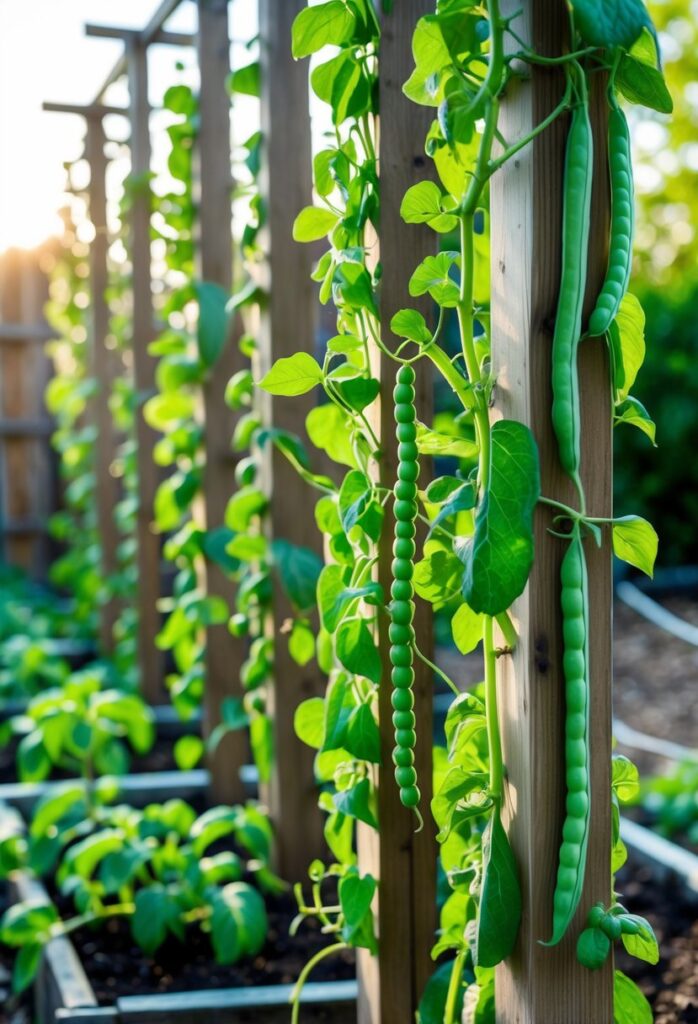
Climbing plants such as beans and peas are ideal for vertical gardening. They naturally grow upward, using tendrils to wrap around supports like trellises. This allows gardeners to save space and keep plants healthy.
Trellises provide sturdy support, helping plants grow tall and strong. They improve air circulation around the plants, reducing the chance of disease. This setup also makes harvesting easier since beans and peas hang within easy reach.
Gardeners can choose from many trellis designs, ranging from simple string setups to wooden or metal frames. A bamboo teepee trellis is a popular rustic option that works well for climbing beans and peas. Custom building a trellis lets gardeners fit the structure to their space and style.
Using a trellis encourages better plant growth and can increase yield. It also adds a neat and organized look to the garden. For ideas and designs on trellises, see this page on beautiful trellis designs.
6) Repurpose old pallets into vertical garden structures

Old pallets can be turned into sturdy frames for vertical vegetable gardens. They provide a simple and affordable way to save space while growing plants upward instead of outward. This is especially useful for small yards or balconies.
To create a vertical garden from pallets, it’s important to secure the wood and line the back to hold soil and plants. Pallets can be filled with pockets or containers to hold different vegetables like herbs, lettuce, or peppers.
Using pallets also supports eco-friendly gardening by reusing materials that might otherwise be discarded. They can be painted or stained to protect the wood and add a clean look.
These structures can be leaned against a wall or fixed vertically with hooks or brackets. With proper watering and sunlight, pallet gardens can hold a surprising variety of vegetables.
More detailed guides on how to build and style these vertical gardens can be found in articles about vertical pallet garden ideas.
7) Utilize vertical hydroponic systems for soil-free gardening
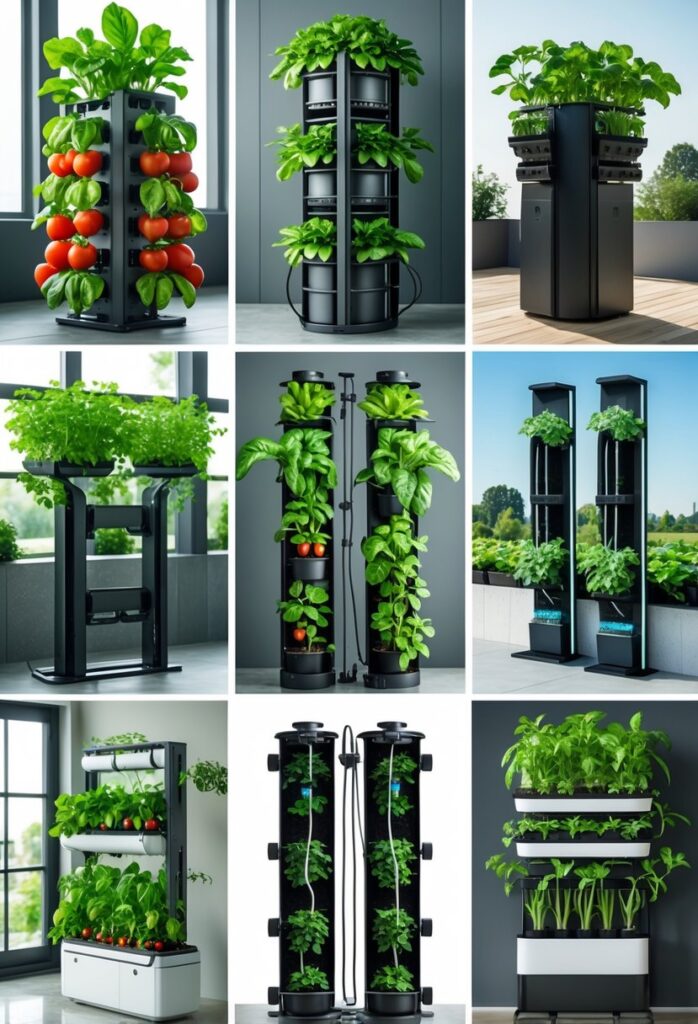
Vertical hydroponic systems let gardeners grow plants without soil. Instead, they use nutrient-rich water to feed plants. This method helps save space by stacking plants upward.
These systems are good for small areas like balconies or kitchens. They also use less water compared to traditional gardening. Plants often grow faster because nutrients go directly to the roots.
Maintenance is simple. Gardeners only need to check water levels, add nutrients, and keep the system clean. Since soil is not used, pests and weeds are less common.
Vertical hydroponic towers can hold many plants in a small area. Common crops include lettuce, herbs, spinach, and strawberries. Some systems cost around $500 but can be built at home for less.
More details on designs and tips for starting a vertical hydroponic garden can be found in this guide to hydroponic vertical gardens.
8) Mount gutter planters on fences for continuous planting

Gutter planters offer a practical way to grow vegetables in limited spaces. They can be mounted directly onto fences, creating a long, continuous planting area. This setup uses vertical space efficiently, which is helpful for small yards or patios.
Each gutter acts as a shallow planter. To prevent waterlogging, drainage holes should be drilled every six inches. This helps keep plants’ roots healthy by allowing excess water to escape.
Vegetables like herbs, lettuce, and small greens grow well in gutter planters. The linear design allows for easy planting and harvesting along the fence line. It also keeps plants off the ground, reducing pest problems.
Installing multiple gutters in rows creates a vertical garden wall. This design maximizes growing space without taking up much room. It also makes it simple to water and care for the plants.
For more detailed ideas on creating vertical gutter gardens, see the guide on how to build a gutter garden.
Key Benefits of Vertical Vegetable Gardens

Vertical vegetable gardens allow gardeners to get more from limited space, improve conditions for plant growth, and reduce the effort needed for daily care. These benefits make vertical gardening a smart choice for many people, especially those with small yards or urban settings.
Space Optimization
Vertical gardens use walls, fences, and towers to grow plants upward instead of outward. This approach works well for small backyards, balconies, or patios where ground space is tight. By planting vertically, gardeners can fit several layers of vegetables in the same footprint that one or two plants would usually take.
This method also frees up space for other uses, like seating or walking paths. In addition, vertical structures can be moved or adjusted, allowing flexibility in how the space is used throughout the growing season. Plants like beans, peas, or tomatoes thrive when trained to grow vertically, making the most of limited areas.
Improved Airflow and Sunlight
Growing plants off the ground improves airflow around leaves and stems. This increased circulation helps lower the risk of fungal diseases and pests that thrive in damp, crowded conditions. Better airflow means healthier plants, which often results in higher yields.
Vertical setups also help plants get more sunlight. When plants are spread vertically, each layer can receive direct sun rather than being shaded by others. This is especially helpful in tight spaces where shadows from buildings or other plants might limit light.
Easier Maintenance
Tending a vertical garden is simpler because plants are raised to a comfortable height. Gardeners don’t need to bend down as much for watering, pruning, or harvesting, which can reduce strain on the back and knees.
Vertical gardens also make it easier to spot problems like pest damage or nutrient deficiencies. The compact design means less weeding and better control over soil quality and moisture. Overall, this method can save time and effort compared to traditional garden beds.
For more ideas on using vertical gardening effectively, see the vertical gardening article at commonsensehome.com.
Materials and Tools Required for Vertical Gardening

A successful vertical garden depends on strong supports and the right growing medium. Choosing durable materials and nutrient-rich soil helps plants grow well in limited space. Several tools also make building and maintaining the garden easier.
Essential Structural Materials
Strong frames or supports are needed to hold plants upright. Common materials include wood, metal, and plastic. Wood is easy to work with and looks natural but needs weatherproofing. Metal frames are sturdy but can get hot in direct sun. Plastic trays or pockets work well for lightweight plants.
Recycled items like pallets, old crates, and gutters are popular choices for vertical gardens and reduce cost. Secure fasteners such as screws, nails, or zip ties keep everything stable. It’s important to check weight limits so the structure holds the soil and plants safely.
Water drainage is crucial. Containers should have holes or mesh bottoms to prevent water pooling, which can damage roots. Adding a backing board behind the frame protects walls from moisture.
Best Soil and Fertilizer Choices
Vertical gardens need lightweight, well-draining soil to avoid waterlogging. A mix of potting soil with perlite or vermiculite helps keep soil airy. Heavy garden soil is not ideal because it can compact and block roots.
Organic compost boosts nutrients and supports healthy growth. Slow-release fertilizers are convenient because they feed plants over time without frequent application. Liquid fertilizers can be used occasionally to give plants an extra boost.
Regular soil checks ensure the mix stays balanced and moist but not soggy. Amending soil with worm castings or natural amendments helps maintain fertility. Proper soil and fertilizer choices reduce plant stress and encourage strong roots in tight spaces.
For more detailed tips on materials and soil care, visit vertical vegetable garden ideas at EcoCation.
Frequently Asked Questions

Vertical vegetable gardening offers many practical solutions for limited space. It often involves creative use of walls, shelves, and containers to grow a variety of vegetables efficiently.
What are some affordable vertical vegetable garden ideas for small spaces?
Using hanging pocket organizers is a low-cost way to create space for herbs and leafy greens. Wall-mounted planter boxes also save room and keep plants easily accessible.
They can build tiered shelves from wood to hold multiple pots. Pallets or reused materials often serve well for these structures, keeping costs down.
How can I create a DIY vertical vegetable garden with limited space?
One simple method is to install trellises for climbing vegetables like beans and peas. This uses vertical space without bulky containers.
People can also repurpose shoe organizers or pocket planters for small herbs. Adding a potato tower helps grow root vegetables upright so the space below is free.
Which vegetables are most suitable for growing in vertical gardens?
Climbing plants such as beans, peas, cucumbers, and tomatoes work well on trellises or cages. Leafy greens and herbs fit nicely in hanging or wall-mounted planters.
Root vegetables like potatoes do well in deep containers or towers designed to hold soil vertically.
What innovative designs can be used for vertical vegetable gardens outdoors?
Potato towers are a popular choice for maximizing root vegetable space. They stack soil and mulch in a tall container, allowing more tubers to grow.
Tiered wooden shelves and pallet gardens create layers for several vegetable pots. Hanging pockets or vertical frames can be combined with other designs to fit balconies or patios.
What are the best vertical gardening systems for vegetables?
Wall-mounted planter boxes and hanging pocket organizers top the list for small spaces. These systems offer easy access and good drainage.
Garden towers designed for vegetables support deep root growth and good airflow. Wooden shelves or pallet racks allow flexible arrangement and can support different plant sizes.
How can I utilize a garden tower for vertical vegetable cultivation?
A garden tower lets gardeners stack soil and plants vertically, saving ground space. They can grow root crops like potatoes by adding layers of soil as the plants grow.
It also helps improve air circulation around plants and can increase overall yield per square foot. Regular watering and occasional fertilizing keep plants healthy in this setup.
